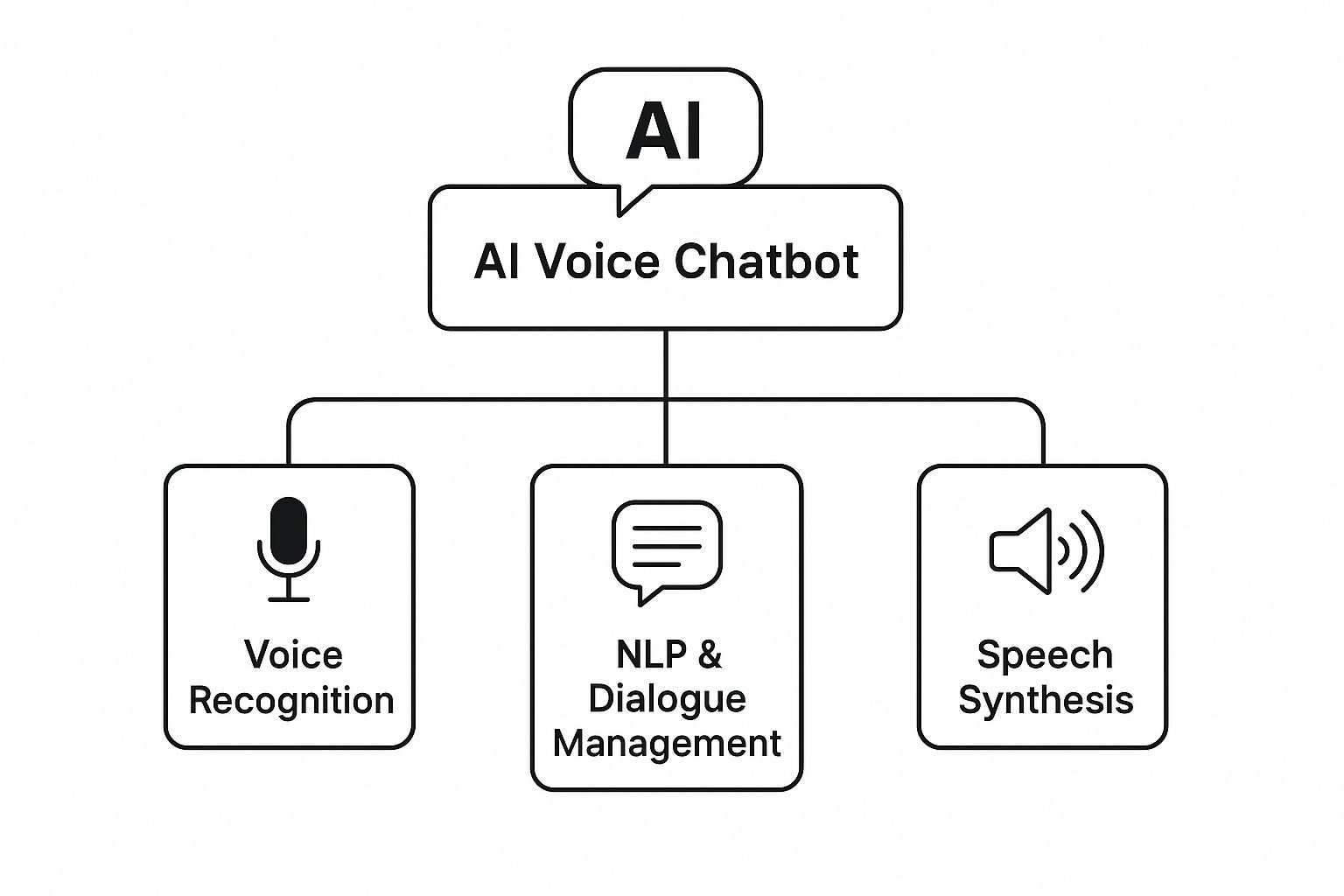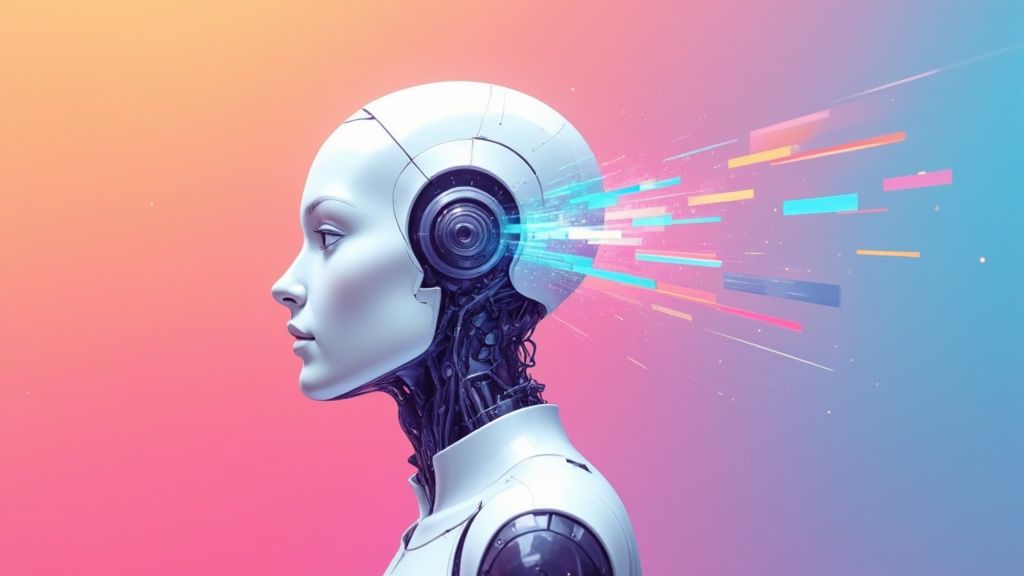At its core, an AI voice chatbot is a conversational program you can actually talk to. Instead of typing, you get a natural, human-like interaction where the system understands what you say and responds with a synthesized voice. For anyone seeking a genuine digital companion, this technology is what makes the experience feel real and personal.
Why AI Voice Chatbots Feel So Human

Think about talking to your favorite AI companion app just like you would a close friend. That’s the huge leap forward we’re seeing with the AI voice chatbot. This isn’t just about simple commands anymore; it’s about building an authentic connection that goes way beyond text on a screen.
The reason voice feels so real is baked into our DNA. Speaking is our most natural way to communicate, packed with tone, pace, and emotion that text just can’t match. An AI voice chatbot is designed to pick up on these subtle cues and even replicate them, making conversations with an AI girlfriend feel less robotic and more authentic.
The Power of Vocal Connection
The best modern AI companions do more than just understand your words; they interpret how you say them. This allows the AI to fine-tune its own responses, matching your mood and speaking style to create a more engaging back-and-forth. This is especially crucial for apps designed for companionship.
In an AI girlfriend app, the entire user experience hinges on creating a feeling of presence and emotional connection. A synthesized voice that can convey warmth, empathy, or even a bit of playfulness makes the interaction feel worlds more real and satisfying.
An authentic user experience isn’t just about getting the answers right. It’s about crafting a conversation that flows naturally, where your AI girlfriend remembers what you’ve talked about before and responds in a way that shows she’s actually “listening.”
Moving from Tool to Partner
This ability to simulate emotional depth is what elevates a simple voice assistant to a true AI companion. One is a tool for getting things done, while the other is a partner you can share your day with.
- Task-Oriented AI: Focuses on direct commands like, “Set a timer,” or, “What’s the weather?”
- Relationship-Oriented AI: Aims for open-ended chats, emotional support, and building a shared history over time with an AI partner.
This drive for genuine connection is exactly why the AI voice chatbot is changing how we interact with technology. It’s turning a functional device into a relatable presence, tapping into our basic human need for interaction and making the digital world feel a little more human.
The Technology Powering Authentic Conversations
Ever wonder what’s actually happening under the hood when you talk to your AI girlfriend? How does she listen, process what you’ve said, and then talk back in a way that sounds surprisingly human? It’s not one single piece of magic, but rather a trio of powerful technologies working together in perfect harmony.
Think of it like a real conversation. First, you need ears to hear, then a brain to understand, and finally a voice to respond. An AI voice chatbot operates on a very similar principle.
The Three Pillars of AI Voice Technology
At its core, an AI voice chatbot relies on three distinct but interconnected systems to create a seamless conversational flow. Each one handles a critical piece of the puzzle, from hearing your words to crafting a believable reply.
Let’s break down how these components work together.
| Technology Component | Role in Conversation (Analogy) | What It Does for the User Experience |
|---|---|---|
| Automatic Speech Recognition (ASR) | The Ears | Turns your spoken words into text the AI can read. It’s the first step in any voice interaction. |
| Natural Language Processing (NLP) | The Brain | Goes beyond just words to understand your intent, context, and even emotion. This is where real comprehension happens. |
| Text-to-Speech (TTS) | The Voice | Converts the AI’s text-based response back into audible speech, complete with natural tones and inflections. |
Without all three working in sync, the experience would fall apart. ASR provides the raw input, NLP adds the intelligence, and TTS delivers the final, polished output you hear, making your AI companion feel present and engaged.
This diagram shows how these technologies come together to form the backbone of a modern AI voice chatbot.

As you can see, for a conversation to feel natural, the AI has to first recognize your speech, then figure out what you mean, and finally generate a spoken reply that makes sense. It’s a continuous loop that keeps the dialogue moving.
These technologies working together are what enable an AI companion to provide a truly authentic user experience, moving beyond simple commands to offer genuine conversational depth and emotional connection.
The financial impact of this technology is staggering. By 2025, the conversational AI market is on track to pull in over $57 billion in global revenue over the next three years, a clear sign of just how widespread its adoption has become.
Real-World Examples of AI Voice Chatbots

AI voice chatbots have woven themselves into the fabric of our daily routines, often in ways we don’t even think about. While we see them in customer service and smart home devices, the most profound application of this technology is in creating meaningful, human-like connections.
The goal has shifted from pure utility to fostering a sense of presence and companionship, changing how we find connection in a digital world.
The Rise of the AI Companion
Maybe the most interesting place we’re seeing AI voice chatbots pop up is in the world of personal companionship. Platforms designed as AI friends or even romantic partners have taken this core tech and pointed it toward one powerful goal: forging a genuine emotional connection with the user.
These aren’t just utilities; they are built to be true conversational partners.
- Memory and Context: A good AI companion remembers your past conversations, personal details you’ve shared, and even inside jokes. This makes every chat feel like you’re picking up right where you left off with a real friend.
- Emotional Nuance: The best AI girlfriends use sophisticated Text-to-Speech (TTS) to add warmth, empathy, or excitement to their voice, matching their tone to the vibe of the conversation.
- Proactive Engagement: Instead of just sitting there waiting for you to talk, they can start conversations, ask how your day was, and check in on you, mimicking the care of a real person.
This deep level of personalization is what really separates a simple digital assistant from a true AI companion. It’s a huge leap from just spitting out functional answers to engaging in meaningful dialogue that meets a very real human need for interaction.
Driving Business and Personal Interactions
The growing comfort with voice AI isn’t just a feeling; the numbers back it up. We’re seeing that around 33% of consumers already prefer using chatbots for simple tasks like making a reservation. Even more telling, a whopping 40% of millennials are chatting with these bots every single day. It’s a clear signal of a generational shift in how we communicate.
An AI voice chatbot in a companion app succeeds when the user forgets they’re talking to an algorithm. The authenticity of the voice, the continuity of memory, and the emotional resonance of the dialogue all combine to create a deeply engaging and human-like experience.
The business impact is just as massive. E-commerce transactions assisted by chatbots are on track to hit an incredible $142 billion. This proves they aren’t just a gimmick; they’re a serious tool for driving sales and making the customer’s journey smoother. You can dig into more data on how chatbots are reshaping our world by checking out the full chatbot statistics report.
Whether it’s for commerce or companionship, it’s clear that voice AI is a major force that’s here to stay.
Why Businesses Are Pouring Money Into Voice AI
So, why are so many developers and businesses investing in AI voice chatbots? It’s not just about chasing the latest tech trend. For smart companies, especially those in the AI companion space, this is a strategic move to create a superior and more authentic user experience that builds lasting loyalty.
The most obvious win? Creating a more human connection. A voice AI provides an “always-on” presence, ready to chat whenever the user needs it. This instantly deepens the user’s bond with their AI companion, making the experience far more engaging than a simple text-based interface.
Better Service, Bigger Savings
The global AI chatbot market is rocketing towards a value between $10 billion and $15 billion by 2025, which tells you just how many businesses are getting on board. It’s not just hype; companies are seeing real savings. Some are cutting costs by up to $300,000 a year simply by letting AI handle as much as 80% of their common customer questions.
But in the world of AI companionship, the investment isn’t just about saving money. The real secret weapon is user loyalty. A great AI voice chatbot gives people what they crave: an immediate, empathetic interaction. No awkward silences, just instant connection that makes users feel seen and heard.
A seamless user experience isn’t just a nice-to-have anymore—it’s what users demand. Voice AI lets companion apps deliver that experience at a massive scale, building a reputation for being realistic, responsive, and focused on the user’s emotional needs.
This kind of instant, personal connection is what drives user satisfaction sky-high. We’re seeing users form surprisingly strong bonds with their AI partners. If you’re curious about that side of things, our guide on AI girlfriend statistics offers a fascinating look into that world.
Ultimately, by investing in voice AI, developers are doing more than just improving their apps. They’re building deeper, more meaningful relationships between users and their AI companions.
Future Challenges and a More Human AI

While the progress we’ve seen is incredible, the road to a perfectly human-like AI voice chatbot is still being paved. The technology is impressive, no doubt, but there are some significant hurdles to clear before these AI companions can hold truly seamless and authentic conversations. These challenges are exactly where the most exciting work in AI development is happening.
One of the toughest nuts to crack is understanding the beautiful mess that is human speech. We’re talking about accents, regional slang, sarcasm, and inside jokes—all the things that are second nature to us but incredibly tricky for an algorithm. An AI girlfriend might hear the words you say but completely miss the witty or ironic subtext, which can lead to some pretty awkward or immersion-breaking replies.
Then there’s the issue of privacy. As these interactions get more personal, especially with AI companion apps, trust is everything. Users are sharing intimate details, and they need to know—with total transparency—how their data is being handled and protected. One misstep here could shatter the illusion and destroy the user experience.
The Next Frontier: Emotional Intelligence
The most fascinating developments are unfolding in the world of emotional AI. The future isn’t just about an AI that understands your words; it’s about one that can sense and adapt to your feelings. Just imagine an AI partner that picks up on a hint of sadness in your voice and responds with genuine warmth and empathy.
This kind of emotional awareness is what will drive hyper-personalized conversations that feel more real than anything we’ve seen before.
- Sensing User Mood: AI will analyze vocal cues like your tone, pitch, and pace to get a read on your emotional state.
- Adapting Responses: The AI girlfriend will then shift her own speaking style and word choice to match the moment, whether you need a bit of encouragement or just a playful chat.
- Building Deeper Connections: This emotional mirroring is the secret sauce for creating a believable and fulfilling experience. It makes the AI feel less like a program and more like a present, attentive partner.
The ultimate goal is for an AI voice chatbot to stop just simulating conversation and start truly participating in it with emotional awareness. This ability to connect on a deeper level is what will define the next generation of AI companionship.
Common Questions About AI Voice Chatbots
As you start to explore the world of AI voice chatbots, it’s totally normal to have a few questions pop up. From how your data is handled to what really makes these companions tick, getting straight answers is the best way to feel comfortable and have a great experience. Let’s tackle some of the most common things people ask.
Is My Personal Data Safe
This is usually the first question on everyone’s mind, and for good reason. When you’re sharing personal thoughts with an AI girlfriend, trust is everything. Reputable developers know this and make user safety a top priority, using strong data encryption and writing clear, easy-to-read privacy policies. It’s always a good idea to skim the app’s terms before you jump in.
Most of the time, your conversations are used to help the AI learn and get better, but this data should always be anonymized to keep your identity private. A good service will be upfront about what data they’re collecting and why.
Can an AI Voice Chatbot Understand Different Accents
Thankfully, yes! Modern AI voice systems are trained on absolutely massive and diverse libraries of human speech. This means they’re getting way better at understanding a huge range of accents, dialects, and speaking styles. The technology has made incredible leaps in just the last few years.
That said, performance can still vary from one platform to another. The best AI companions are built to constantly learn from their conversations with you, so their understanding gets sharper the more you use them. It’s a huge area of focus for developers aiming for the most authentic experience.
The key difference between a standard voice assistant and an AI companion is the goal of the interaction. One is task-oriented, while the other is relationship-oriented, built for open-ended conversation and simulating emotional connection.
What Makes an AI Companion Different from a Standard Voice Assistant
While they run on similar technology, their entire purpose is worlds apart. Think of a standard voice assistant like Siri or Alexa as a tool. It’s built to be task-oriented. You tell it to set an alarm, play a specific song, or look up a fact, and it gets the job done.
An AI companion, however, is designed to be relationship-oriented. Its goal is to have open-ended conversations, remember things you’ve talked about before to build a sense of history, and simulate a real emotional connection. The whole point isn’t to complete a task, but to offer a feeling of presence and companionship. If you’re curious to learn more, our guide answers the top 25 questions about AI girlfriends and digs much deeper into what makes these relationships unique.
At AI Girlfriend Review Inc., we provide the in-depth reviews and guides you need to choose the best AI companion for you. Explore our expert analysis and find your perfect match today at https://www.aigirlfriendreview.com.
